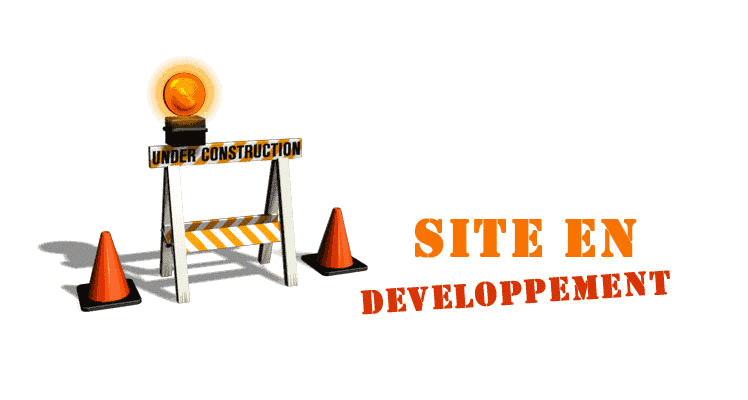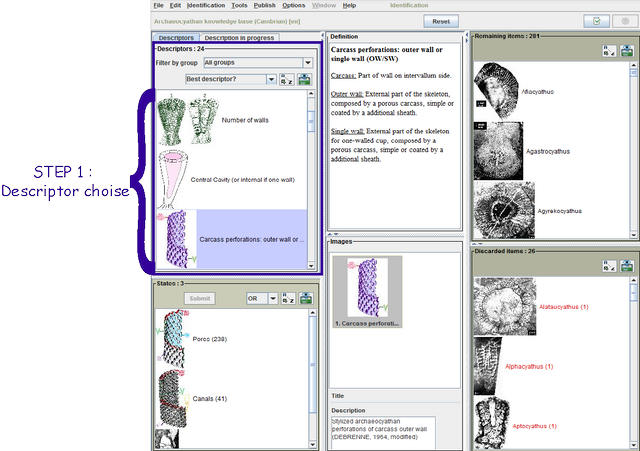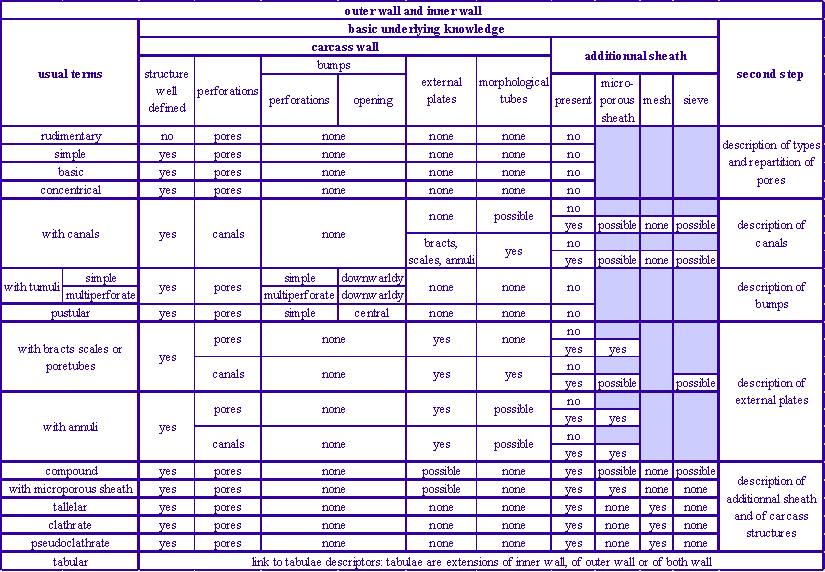 HOME
HOME


 License
License How to cite
How to cite ARCHAEOCYATHA
ARCHAEOCYATHARole in Cambrian
Morphology
Bibliography
 KNOWLEDGE-BASE
KNOWLEDGE-BASEGenera: 308
Groups: 10
Descriptors: 122
Properties
 INTERACTIVE KEY
INTERACTIVE KEYUser guide
Matching terminologies
Glossary
 PUBLISHED KNOWLEDGE-BASE
PUBLISHED KNOWLEDGE-BASE CONTRIBUTORS
CONTRIBUTORS
 CONTACT
CONTACT
Visitors:
Last modified : 6 December 2012
- ARCHAEOCYATHA - User guide
User guide of the application

User guide will be updated soon

Example of identification module
XPER˛ interface is composed of three parts:
- A: Free Access key with at top the list of descriptors and at bottom their states
- B: Information about the descriptors: definitions and pictures explaining the descriptors and their states
- C: The lists of genera with at top still possible genera (remaining items) and at bottom eliminated genera (discarded items)
Different tools can be used to facilitate the identification:
- 1: List of descriptors which can still be used
- 2: List of descriptors which has already been used, here, you can change your states choice for each descriptor
- 3: Filter by group: to see the descriptors linked to particular part of the skeleton or to particular cross-section
- 4: Sorting descriptors by discriminatory power: it advices you about decriptors you should use to discriminate more genera.
- 5: When you choose several states you can add different logical operators: OR, XOR, AND, NOT, NOR, NXOR, NAND
- 6: Sorting descriptors, states or genera by alphabetic order
- 7: Displaying or concealing miniature pictures
- 8: Reset: to begin a new identification
- 9: (1), (2)... inform you about the number of states which are different of your choice.
Identification consists of the repetition of successive steps:
Firstly, the choice of a descriptor

Secondly, the choice of one or several states of the descriptors

Finally a confirmation with the submit button.

At each validation, lists of remaining and discarded taxa and list of possible descriptors are updated.
More information: http://www.infosyslab.fr/lis/?q=en/resources/software/cai/xper2/documentation_en/FAQ_use#identification
Adapted terminology
A classical diagnosis often follows this pattern:Outer wall + one complex descriptive term, inner wall + one complex descriptive term, type of radial structure +/- other intervallar structure (tabulae…)
With such a structure, vocabulary homogenization is not adequate. Reconciling traditional morphological terms is necessary in character construction for databasing, descriptions should be standardized with basic descriptors only. Since one term of traditional terminology often implies several basic descriptors, each character is examined from all aspects and only basic descriptors are retained. Moreover, when basic descriptors are defined, these should be organized into groups with a similar morphology to make easy the identification. This new organization of descriptors means the appearance of new terms and the disappearance of some usual terms. (see From a traditional terminology to an adapted one) The main difference between the traditional terminology referring to archeocyathan and one adapted to a knowledge-base concerns the description of walls and their porosity.
Walls
We considered that a wall can be composed by one or two parts. The first one, always present, is named a carcass wall and the second is an additional wall.
A carcass wall generally has perforations (pores or canals) and may have different structures: bumps (tumuli, putulae) or external plates (spines, bracts, scales, annuli).
Additionnal walls group together the microporous sheaths, sieves formed by protrusions (compound walls: incipient pore subdivision and completely subdivided pores) and mesh (tabella, clathri, pseudoclathri).
This new organization included all usual walls types apart from tabular walls that are considered to be linked to tabulae. Differences are summarized in these tables :

Usual terminology of walls dissected into basic descriptors

Usual terminology of walls pores dissected into basic descriptors
Tabulae
Tabulae have been subdivided into two descriptors: one describes their construction, the other the porosity of tabulae.

Cross-reference table of tabulae terminology
Modified terms
Some terms are modified for different reasons in the knowledge base:
- Spines: they were used for two different structures: for external plates that look like bracts and for skeletal elements that divided pores to form an additional sheath. In the first case, the term “spines” is retained whereas the second corresponds now to “protrusions”.
- Sub-spherical chambered canals: it may easily be confused with something links to “chamber” that's why it's replaced by the term “curved canals”.
- Canals communication: the terminology referring to communicating canals appears difficult to understand for neophytes. Non porous, porous and spongiose replace non-communicating, simple communicating and anastomosing.
Some terms illustrating complex characters become useless after their division into basic descriptors:
- Tumuli and pustulae: With basic descriptors, a bump is described with its perforations oriented to the opening direction and the terms “tumuli” and “pustulae” presence become redundant and inadequate.
- Cambroid pores and anthoid pores: Since pores are defined with some basic descriptors (their type (or shape), their distribution, their arrangement...), cambroid and anthoid pores became useless terms. See Usual terminology of walls pores dissected into basic descriptors to know how these terms are defined now.
- Basic and rudimentary walls: See Usual terminology of walls pores dissected into basic descriptors to know how these terms are defined now.
- Pseudotaeniae: its definition is “taeniae with synapticulae at each interpore node”. So, in the knowledge-base, it results in a descriptor association: vertical intervallar structures are taeniae and links are synapticulae which repartition is at each interpore node.
